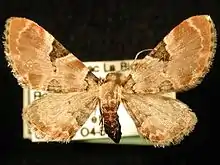Eupithecia stellata
Eupithecia stellata is a moth in the family Geometridae first described by George Duryea Hulst in 1896. It is found in North America from central Manitoba to northern Alberta and south to California and Mexico.[3]
| Eupithecia stellata | |
|---|---|
 | |
| Scientific classification | |
| Kingdom: | Animalia |
| Phylum: | Arthropoda |
| Class: | Insecta |
| Order: | Lepidoptera |
| Family: | Geometridae |
| Genus: | Eupithecia |
| Species: | E. stellata |
| Binomial name | |
| Eupithecia stellata | |
| Synonyms | |
| |
The wingspan is about 20 mm. Adults have mottled brown-pink forewings crossed by irregular black basal and median bands. The hindwings are paler than the forewings and have dark grey-pink shading along the outer margin. There are two generations with adults on wing in early June and again from late July to the beginning of September.[4]
References
- Yu, Dicky Sick Ki. "Eupithecia stellata (Hulst 1896)". Home of Ichneumonoidea. Taxapad. Archived from the original on March 25, 2016.
- "910402.00 – 7564 – Eupithecia stellata – (Hulst, 1896)". North American Moth Photographers Group. Mississippi State University. Retrieved May 3, 2019.
- Rindge, Frederick H. (July 25, 1963). "Notes on and descriptions of North American Eupithecia (Lepidoptera, Geometridae)" (PDF). American Museum Novitates. 2147: 1–23.
- Anweiler, G. G. (2008). "Species Details: Eupithecia stellata". University of Alberta Museums. E.H. Strickland Entomological Museum. Retrieved December 29, 2020.
| Wikimedia Commons has media related to Eupithecia stellata. |
| Wikispecies has information related to Eupithecia stellata. |
This article is issued from Wikipedia. The text is licensed under Creative Commons - Attribution - Sharealike. Additional terms may apply for the media files.